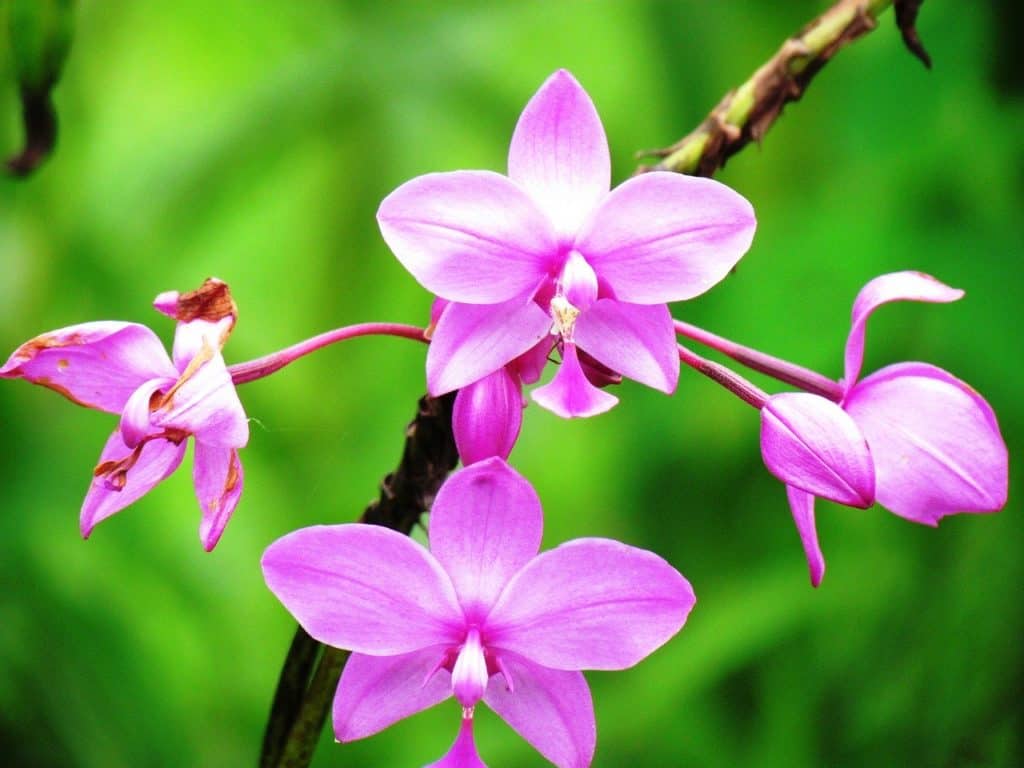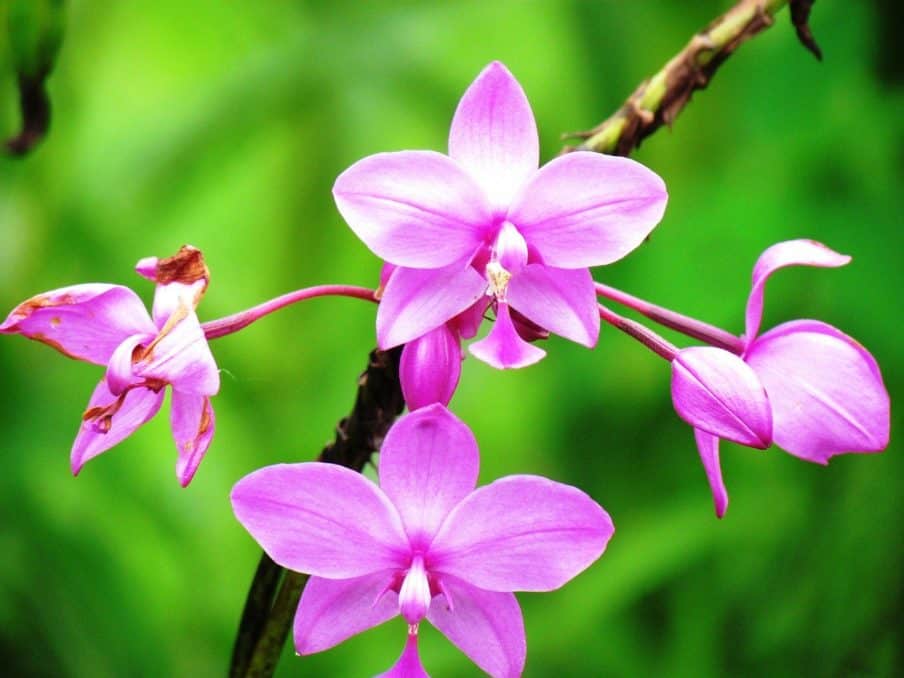
Costa Rica, a jewel of Central America, is renowned for rainforests, wildlife, and its culture. Among its treasures is the Guaria Morada, the national flower, a beautiful orchid that embodies the country’s natural beauty and cultural heritage.
Known scientifically as Guarianthe skinneri (formerly Cattleya skinneri), this vivid purple bloom captivates locals and visitors alike. In this post, we’ll look into the Guaria Morada’s history, ecological role, cultural significance, where to find it, and how to cultivate it, ensuring you have all the details to appreciate this iconic orchid.
What Is the Guaria Morada?
The Guaria Morada, meaning “purple orchid” in Spanish, is an epiphytic orchid native to Central America, thriving from southern Mexico to Costa Rica. Its striking purple petals, ranging from deep violet to soft lavender, making it a standout among Costa Rica’s 1,500+ orchid species. As an epiphyte, it grows on trees or rocks, drawing nutrients from air, rain, and organic debris, not as a parasite but as a harmonious partner in its ecosystem. The orchid blooms from January to April, peaking in March, when its large, fragrant flowers transform Costa Rica’s landscapes into a purple spectacle.
The Guaria Morada’s pseudobulbs—thickened stems that store water—help it survive dry periods, while its broad, fleshy leaves capture sunlight in humid forests. Pollinated primarily by bees and occasionally hummingbirds, it supports local biodiversity by fostering microhabitats for small creatures. This ecological role underscores Costa Rica’s commitment to conservation, as the flower thrives in balanced, sustainable ecosystems.
A Rich History: How It Became the National Flower
The Guaria Morada’s journey to national emblem began in 1936, sparked by a request from Argentina’s Jardin de La Paz, which sought Costa Rica’s national flower for a global garden display. At the time, Costa Rica had no official flower, prompting the Garden Club and Rotary Club to organize a nationwide vote in 1937. Horticulturists, students, and community members chose the Guaria Morada for its deep ties to Costa Rican traditions and its American origins, reflecting the nation’s identity. On June 15, 1939, President León Cortés Castro officially declared it the national flower via Decree No. 24.
The high regard for this orchid grew further. In 1972, President José Figueres Ferrer established the second week of March as Costa Rican Orchid Week, celebrating the Guaria Morada’s peak bloom and the nation’s orchid diversity. This annual celebration, organized by the Costa Rican Orchid Association, highlights the flower’s enduring legacy. A 1934 folk song, “Guaria Morada,” further cements its place in cultural lore, capturing the Tico spirit of pride and harmony.
Where to Find the Guaria Morada in Costa Rica
Spotting a wild Guaria Morada can be a challenge due to overcollection, which has made it rare in natural habitats. Now protected by the government, wild populations are preserved, and many orchids seen today are cultivated. They thrive in humid, premontane forests at elevations of 500 to 1,500 meters, preferring temperatures between 15°C and 24°C and rainfall of 1,500 to 3,000 mm annually.
The Central Valley, Pacific coast, and isolated areas like Guanacaste, the Nicoya Peninsula, and Tilaran ridges are prime locations. Monteverde’s cloud forests, among the world’s densest for orchids, offer a good chance to see them perched high in tree canopies.
For a less adventurous experience, visit the Lankester Botanical Garden in Cartago, managed by the University of Costa Rica. This renowned garden showcases a vast orchid collection, including the Guaria Morada, and offers educational tours about Costa Rica’s flora.
Rincon de la Vieja National Park is another hotspot, where you can combine orchid spotting with rafting or soaking in hot springs. Orchid enthusiasts can also attend the Alajuela Orchid Show, held in March and October, which raises awareness about endangered species like the Guaria Morada and fosters community pride.
Many Costa Rican households cultivate the orchid, reflecting its cultural importance. You might spot it adorning gardens, courtyards, or even adobe walls in traditional cities like Cartago, Escazú, or Santo Domingo de Heredia, though modern architecture and earthquakes have reduced this practice.
Cultural Significance: A Symbol of Tico Identity
The Guaria Morada is more than a flower—it’s a cornerstone of Costa Rican identity. Symbolizing peace, love, harmony, and good fortune, it’s deeply woven into folklore and traditions. Ticos believe it brings luck to homes, and its radiant purple is said to reflect the beauty of Costa Rican women. Historically, indigenous women adorned their hair with its blooms, and families grew it on rooftops or clay tiles, a custom now less common due to commercialization.
During Lent and Holy Week, the Guaria Morada decorates church altars and processions, earning it the title of the “heraldic flower” of these celebrations. Its presence in religious settings underscores its role as a mystical emblem of faith, inherited from generations past. Families often compete at orchid shows to showcase the most vibrant blooms, fostering community pride and preserving cultivation traditions. The flower’s elegance and resilience mirror Costa Rica’s commitment to nature and cultural heritage, making it a beloved national treasure.
Cultivating the Guaria Morada: Tips for Enthusiasts
Interested in growing your own Guaria Morada? While it requires care, its beauty is worth the effort. Below is a table summarizing key cultivation tips for success:
| Aspect | Details |
|---|---|
| Light | Bright, indirect sunlight; filtered shade mimics forest canopies. |
| Temperature | 15°C–24°C; avoid extreme heat or cold. |
| Humidity | 70% or higher; mist regularly or use a humidity tray. |
| Mounting | Attach to bark, cork, or tree ferns; avoid soil as it’s an epiphyte. |
| Watering | Water when mount dries out; use rainwater or distilled water. |
| Fertilizer | Apply balanced orchid fertilizer (e.g., 20-20-20) monthly during growth. |
| Blooming Season | January–April; ensure proper care year-round for vibrant blooms. |
Avoid overwatering, as epiphytes are prone to rot. For beginners, purchasing from reputable nurseries or “viveros” ensures healthy plants and supports conservation efforts, as wild harvesting is discouraged.
Conservation Efforts: Protecting a National Treasure
The Guaria Morada’s popularity has led to overcollection, reducing its wild presence. Costa Rica’s government, alongside NGOs and botanical institutions like Lankester Botanical Garden, promotes sustainable cultivation and habitat preservation. Eco-tourism initiatives educate visitors about protecting orchids, encouraging purchases from ferias rather than wild harvesting. These efforts align with Costa Rica’s broader commitment to preserving its 5% share of global biodiversity, ensuring future generations can enjoy this iconic flower.
Plan Your Visit: Experience the Guaria Morada
Whether you’re a nature lover, culture enthusiast, or casual traveler, the Guaria Morada offers a window into Costa Rica’s soul. Visit in March during Orchid Week for festivals and peak blooms, or explore botanical gardens and national parks year-round. From Monteverde’s misty forests to Alajuela’s vibrant orchid shows, the Guaria Morada awaits, ready to inspire with its beauty and story.
For more on Costa Rica’s natural wonders, check out our guides to Monteverde, Rincon de la Vieja, and Lankester Botanical Garden. Pura Vida!

